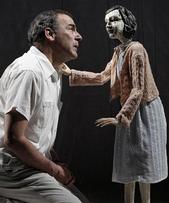SITE GUIDE
SEARCH
REVIEWS
REVIEW ARCHIVES
ADVERTISING AT CURTAINUP
FEATURES
NEWS
Etcetera and
Short Term Listings
LISTINGS
Broadway
Off-Broadway
NYC Restaurants
BOOKS and CDs
OTHER PLACES
Berkshires
London
California
New Jersey
DC
Connecticut
Philadelphia
Elsewhere
QUOTES
TKTS
PLAYWRIGHTS' ALBUMS
LETTERS TO EDITOR
FILM
LINKS
MISCELLANEOUS
Free Updates
Masthead
A CurtainUp Review
Compulsion
By Elyse Sommer
|
What are you doing here?— Mrs. Silver. I've always been here. You know that.— Anne Frank Get out of our bed.— Mrs. Silver He wants me here. You know that, too..— Anne Frank. |

Mandy Patinkin and Anne Frank Mannekin
(Photo: Joan Marcus) |
Like so many famous (and in this case, infamous) personalities, Leopold and Loeb have been magnets for other writers — for example, John Logan's Never the Sinner which preceded his London and Broadway hit Red about the painter Mark Rothko, and Stephen Dolginoff's operatic musical Thrill Me.
But Rinne Groff's latest play is not yet another spin on Levin's, or anyone else's, exploration of what compelled these rich college boys to commit a senseless murder. Her Compulsion is about author Levin's own compulsive battle to dramatize Anne Frank's famous diary. As Levin changed his killers' names but adhered closely to the facts, so Groff has created a Meyer Levin doppelganger named Sid Silver. Call him Silver or Levin, this Compulsion is all about Levin and his emotionally self-destructive, 30-year battle for bringing his play version of the famous diary to the stage.
Levin-cum-Silver, who as a World War II war correspondent visited the camps where so many victims like Anne Frank and her family perished, had a vision of Anne as a much needed reporter or "teller from within" rather than an observer. He considered such a "teller" crucial for making as many people as possible aware of the never to be forgotten meaning of the holocaust. Thus Groff's play begins with Silver meeting with two Doubleday Publishing Company editors to champion his friend Otto Frank's effort to get the Diary published.
While Silver is happy to learn that Doubleday will indeed publish the book, that meeting marks the beginning of the end of the impassioned writer's loss of control: A prominent non-Jew, Eleanor Roosevelt, is chosen to write the introduction to the book. As Mrs. Roosevelt's was thought to be a better choice than Levin to make the play a universal and inspirational story, so the the publishers and the play's producers thought that Levin's play adaptation would be too dark and Jewish. Thus, from that first cordial meeting in the Doubleday offices, Groff chronicles Silver's mounting self-destructively obsessive outrage and various legal battles. Involved were not just the publishers and the producers of the play by two non-Jewish screenwriters that won a Pulitzer, but the man who controlled the Anne Frank legend — her father, Otto Frank. It's a conflict that plays out over thirty years including the final semi-triumph, a production of the play as written by Levin in Israel where he eventually moved.
Whether singing or in a straight drama, Mandy Patinkin is a performer who fiercely dominates any stage he's on. The passionate and self-righteous to the point of paranoia Silver is a role made to order for Patinkin's operatic style of acting. But while it's Patinkin's Silver who represents the play's title and it's Patinkin's name that is the box office draw, the most memorable character is Anne Frank — in this play that's Anne Frank as portrayed by a near life-sized marionette. It is whenever the puppet manipulator loosens the string of that puppet-Anne and allows her to take center stage that we feel a tugging at the string controlling our hearts. It is that puppet-Anne at the center of this much publicized quarrel about the ethics of dealing with cultural legends and their work who gives Compulsion its unique dramatic impact.
As she followed Meyer Levin's example by changing her main character's name, Rinne Groff came up with this unique presentation style by also channeling his background with a Chicago marionette theater. The puppets (beautifully designed by Matt Acheson and expertly manipulated by pupeteers Emily DeCola, Daniel Fay, Eric Wright) include replicas of several of the play's flesh and blood characters. But Anne Frank is represented strictly in this form.
As someone who had a Dutch family branch that fell victim to the Nazis as the Franks did, I've always felt sympathetic to the book and the original as well as the later play version because, flawed or not, they helped to keep the Holocaust alive. I was therefore apprehensive about trivializing the Anne Frank story as a puppet show. In a way my apprehensiveness was justified even though the way Groff uses this concept is something of a metaphoric master stroke. What better way to drive home the idea that Anne Frank's legacy has been manipulated to become a template for various interpretations of how her story could best serve humankind's remembrance of and dealing with one of the travesties of the last century? By portraying Anne in this form, the play strikingly encapsulates the essence of Levin's quarrel with Otto Frank and all involved with the 1955 play, at the heart of which is the accusation that they appropriated Anne's true account of her family's tense, hidden years under Nazi occupation.
The way Groff uses her actors to give different voices to Anne adds to the contribution of this concept to the play's effectiveness. Most of the time the voice we hear is that of Hannah Cabell who plays Silver's wife and the Doubleday editor who is the same age as Anne Frank would have been had she lived; but to underscore the havoc Silver's obsession has caused to his family, there's the play's most unforgettable scene when we see the puppet in bed with the writer and his wife and Mandy Patinkin's Silver speaks for her.
Serving as the Anne Frank puppet's main voice is just one of Hannah Cabell's considerable contributions here. She brings nuanced individuality to both Silver's long suffering but loyal wife as well as the at first sympathetic book editor who rejects him when he persists in his lonely battle. As Silver's charming and much younger wife who tries to save him from destroying himself and their family and who is actually the only really sympathetic live character on stage.
Patinkin's character, while understandably distraught about seeing his vision and participation in executing it usurped, is too self-righteous and, yes, compulsive, to win our hearts and minds. Patinkin works hard to charm us with Silver as a bossy but loving and romantic husband, and to help us to empathize with his concerns about anti-Semitism persisting in post-War America and the homogenized treatment of the 1955 play. However, the arguments against everything about the play ignore its positive effects in terms of keeping the Holocaust alive; in fact, some of Levin's rants provided fodder for the Holocaust denial crazies. What's more, try as he might, Patinkin can do just so much to make Silver convincingly lacking in personal ambition. The main blow to our sympathy for him comes when the action moves to Israel and we hear some of Sid's narrow-minded views about Palestine and Israel. Ultimately, the actor's biggest problem in remaining the star of this enterprise is that the man he portrays simply isn't as interesting as the young girl with whose story he became so obsessed.
Matte Osian, the third "live" cast member, displays enormous versatility in taking on four roles, and managing to differentiate between the first three, all of whom are anti-Semitic. Director Oskar Eustis has also insured a well-oiled, vivid production by assembling top-notch designers, with Jeff Sugg's video and projection design particularly effective in creating a story enhancing stage picture.
Ultimately Compulsion teeters precariously on doing what Levin accused his "enemies" of doing: Exploiting a popular culture icon and being a bit too inventive to avoid a sense of excessive artfulness. Speaking of excess, there's the detailed dialogue about subsidiary rights and other contractual matters. As a longtime author's agent I found all this rather interesting, but I fear the people without firsthand knowledge of the book business would be more inclined with a less-is-more approach.
For fans of Mandy Patinkin's mellifluous singing, he does sing. But just once, and all too briefly.
Review of other plays by Rinne Groff
Compulsion pre-Public production at Yale Repertory
Saved Book for 2008 musical at Playwrights Horizon
What Then-2006
Ruby Sunrise - 2005 - also at the Public and directed by Oskar Eustis
Inky - 2005
Jimmy Carter was a Democrat-2002
Hysterical Girls Theorem;- 2000
Reviews of The Diary of Anne Frank -- both use the Wendy Kesselman adaptation which addressed complaints not limited to Levin about the play's fell-good emphasis and lack of Jewishness.
Wendy Kesselman's adptation-Broadway- The 15-year-old actress playing Anne Frank lent a special poignancy to the role since she was born in Israel with Holocaust victims in her family. Her name: Natalie Portman.
Kesselman adaptation at Papermill Playhouse
|
Compulsion By Rinne Groff Directed by Oscar Eustis Cast: Hannah Cabell (Miss Mermin, Mrs. Silver), Mandy Patinkin (Mr. Silver), Matte Osian (Mr. Thomas, Mr. Harris, Mr. Ferris, Mr. Matzliach), Emily DeCola, Daniel Fay, Eric Wright (puppeteers) Scenic Design: Eugene Lee Costume Design: Susan Hilferty Lighting Design: Michael Chybowski Sound Designer: Darron L.West Puppet Design & Supervision: Matt Acheson Stage Manager: Buzz Cohen Running time: 2 hours 15 minutes with a 15 minute intermission Public Theater (co-production with Berkeley Repertory Theatre & Yale Repertory Theatre)/Martinson, 420 Lafayette Street 212/968-7555 www.publictheater.org Tues-Friday 8pm; Saturdays 2 and 8pm, Sundays at 2pm From 2/12/11; opening 2/17/11; closing 3/13/11. Reviewed by Elyse Sommer at February 11th press preview |
|
REVIEW FEEDBACK Highlight one of the responses below and click "copy" or"CTRL+C"
Paste the highlighted text into the subject line (CTRL+ V): Feel free to add detailed comments in the body of the email. . .also the names and emails of any friends to whom you'd like us to forward a copy of this review. Visit Curtainup's Blog Annex For a feed to reviews and features as they are posted add http://curtainupnewlinks.blogspot.com to your reader Curtainup at Facebook . . . Curtainup at Twitter Subscribe to our FREE email updates: E-mail: esommer@curtainup.comesommer@curtainup.com put SUBSCRIBE CURTAINUP EMAIL UPDATE in the subject line and your full name and email address in the body of the message. If you can spare a minute, tell us how you came to CurtainUp and from what part of the country. |

Slings & Arrows-the complete set
You don't have to be a Shakespeare aficionado to love all 21 episodes of this hilarious and moving Canadian TV series about a fictional Shakespeare Company






